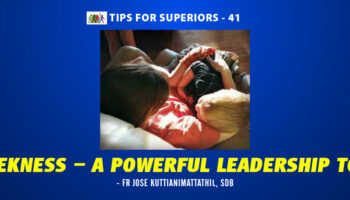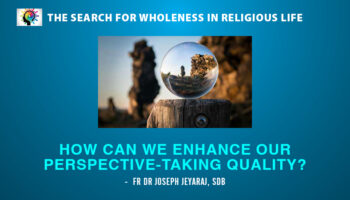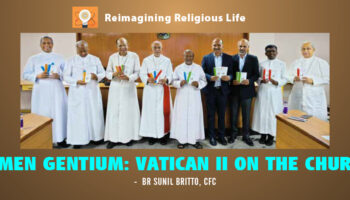Basing himself on his experience of working with men condemned to death for serious crimes, Brother Carmel shares what he learnt about these men, how he now sees capital punishment and the meaning of Redemption—for the prisoners and for us.
I was elated when on August 2, 2018, Pope Francis declared that the Death Penalty was inadmissible under any circumstance. I was also glad that even Bishop Theodore Mascarenhas, Secretary General of the Catholic Bishops’ Conference of India, positions the same statement, while respecting the law of the country. At the same time he doubts whether it will solve the issues. And I agree with him!
Before coming to India, I was working as a Chaplain in one of the biggest jails in California—Men’s Central Jail in downtown Los Angeles. For ten years, on a daily basis I would meet young men who were still awaiting their trials. A lot of them, being there for a heinous crime, were facing the death penalty. Some of them were as young as eighteen. For some of them it was their first crime ever. Others were seasoned “criminals.” After being sentenced, they were sent to Death Row in St. Quentin. That is where I would visit some of them at least once or twice a year.
Twice I took the witness stand in a Los Angeles Court for two inmates. People ask me why I did it. Weren’t they murderers? I’d use Don Cabana’s words from his book, Death at Midnight, “I knew this man. I believed his life was worth saving.” It was after these trials that I started getting interested in the death penalty, its implications and ramifications.
Marvin: A Cruel Gang-Leader, Murderer and Yet…
I clearly remember the morning when I took the stand to witness in favour of Marvin. Marvin’s story was one of true and sincere redemption. He was one of the founders of a big Asian gang, and consequently he was convicted of eight murders and ten attempted murders committed in the early 90s. In one of the murders, Marvin and two other assailants committed a home invasion robbery in Los Angeles in the middle of the night and, when confronted, they executed the father in the presence of his wife and small children. In another murder incident, he threw a hand-grenade into a large crowd of young adults gathered in a parking lot outside a dance hall and, after the grenade failed to detonate, bitterly complained later to fellow gang members about the grenade failure. In 1996, Marvin fled from the U.S. and, settling in another country under an assumed name, he carved out a new life and embraced a path toward redemption, during which time he rejected the gang life style, operated two successful businesses, actively participated in the Church and married into a prominent family. After ten years, he was caught and extradited to Los Angeles. I met Marvin a few days later when he was booked in Men’s Central Jail.
On February 28, 2011, I took the witness stand for Marvin. Testifying in court is not a pleasant experience, especially when your friend or family member has just been found guilty of cruel and heinous crimes. It’s not easy when the families of the murdered victims, whose life changed tragically the day your friend decided to kill their loved one, are there in front of you listening to you pleading for his life when you know that nobody was pleading for the life of their loved ones when he killed them.
Relatives of the accused cannot enter the court room to give support, at least with their presence, to a dear one; thus the prisoner spends the whole duration of the trial alone. I remember the trial of Richard—a young man—whose mother (who lived pretty far away) used to go to court every day and sit outside alone in the hallway while her son was being tried.
Can you imagine the pain a mother has to bear when she hears the prosecutor calling her son a monster? She had conceived and given birth to a monster. This and other questions used to haunt me. What if I’m wrong? What if I’m on the wrong side of the courtroom? Why am I on the side of a murderer? I remember sharing this dilemma with my father on the phone one Sunday morning during one of the trials and he simply told me, “My son, do what you need to do in order to save his life. He’s too young.” That was what I needed to hear.
Yes, I would return to the witness stand if needs be, even at the expense of being jeered at by the prosecutor and called insensitive to the pain of the victim’s family (which I’m definitely not), naïve (after 15 years working with inmates I do get a sense of who’s lying, who’s trying to take advantage of me, and who’s genuine) or a weird Catholic priest. Well, this I accept. Yes, I am weird, to be on the side of a murderer and see some goodness in him.
—————————————————————————————————————————————————————
Three Myths
There are three myths associated with the death penalty:
- The Myth of Closure: After 18 months, Omar pleaded guilty to a crime he had committed. Together with his public defender, district attorney and the victim’s family, he agreed to take a sentence of life without the possibility of parole. Omar went to prison for life and the victim’s family can hopefully start the process of This is what I consider closure. When a death sentence is applied on a prisoner, he will have to go through so many appeals before he is actually executed. The pain and suffering of both families—the victim’s and perpetrator’s—are relived over and over again each time the inmate has a court hearing. That is definitely not closure.
- The Myth of Deterrence: up till now I have never met anybody who told me that he stopped half way from committing a crime because he became aware of the possibility he may be executed. Generally speaking, murders are committed under three circumstances: the first, out of passion and rage, g., when a man comes back from work and finds his wife in bed with another man, takes out the gun and shoots him/them; the second for money (including gang related murders), where a capital crime is calculated and coldly premeditated; the third because of mental sickness. In all these cases, no one will ever stop midway thinking about the death penalty.
- The Myth of Proportionality: meaning that only the worst-of-the-worst get the ultimate penalty. This is not true. Usually it is the ones who do not have money for an excellent team of lawyers and investigators who get the Death Penalty—meaning: the rich get life in prison and the poor get the Death.
* * *
Why Do You Do This Ministry?
People ask me “How can you do it?” My first reaction is, “How can I not do it?” But to tell you the truth, I do ask the same question myself. Let me give a couple of reasons:
There is surely some kind of identification with the men I meet in prison. Like them I am locked up in my compulsions, obsessions, defects of character and because of this, there is a deep need inside of me for wholeness, for a clear understanding of who I am, what am I doing and a desire to be free of all that shackles me. A few months before I left Los Angeles, I visited Christian on death row in San Quentin. During the five- hour visit, locked with Christian inside a one-point-five-square-meter cage, he brought up the subject of making amends to the victim’s family. We talked for a long time about the reasons why he wanted to make the amends and the possibilities of how to make them. It was a heartfelt conversation which came up unexpectedly for me, and for which I am so ever grateful. I remember telling him, “Christian, whether or not you make amends, you will always have this pain to carry your whole life.”
We continued to write, but Christian put one condition, never to mention God or religion in my letters. I kept my side of the deal. Five years later he finally broke his side. In a letter dated January 23, 2014, he wrote:
“I’m sometimes not familiar with who I am anymore. I experience these emotions I’ve never felt before and it freaks me out! Am I crazy, my dearest friend? No, I am not, I’m just going thru it . . . and its tuff! But smile, ‘cause guess what? . . . I’ve been praying! I don’t know to who, but I’m praying. And don’t you start talking about Jesus! I’m just praying to whatever creator there is.”
Beautiful! Sheer beauty. I imagine God and Christian having a tête-a-tête inside San Quentin.
These are the fleeting moments of joy and consolation in my life. I am honoured to receive such letter. Honoured to know and consider Christian an intimate friend, and especially be present at the moment of the rekindling of the spark. At the same time, I experience pain and suffering. In the past years I have been trying to come to grips with this incessant feeling that the only way I can become who I am meant to be is through the dark path of pain. Experiencing the pain of the men I meet daily, locked up behind bars—the pain of listening and absorbing their darkness, their sins, their murders, their rapes, their embezzlements, their gang fights, their being abandoned by their family, their passing through court trials on their own, their denial of their involvement in the crimes, the sheer callousness and coldness of what they were capable of doing.
As Claudia—a forensic psychologist and mitigating specialist—once wrote to me: “We are in the most wonderful of professions. We hear secrets. We listen to compelling stories. Yes, sometimes our days are filled with outcries of despair, frustration, repetitive self-defeating behaviours and a variety of other stigmata that flow from the wounds of human psyches. Sometimes, though, we bear witness to radiant triumphs and even to the sudden and unpredictable raining down of goodness on one or another of our clients.”
Brother Carmel is a Missionary of Charity (MC) for the past 28 years, lived in Colombia, Peru, Guatemala and Los Angeles (where he mainly worked in prisons) and for the past year in Kolkata. He is originally from Malta.





